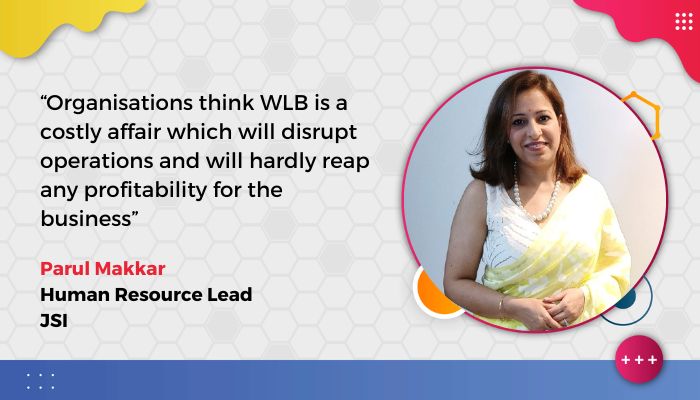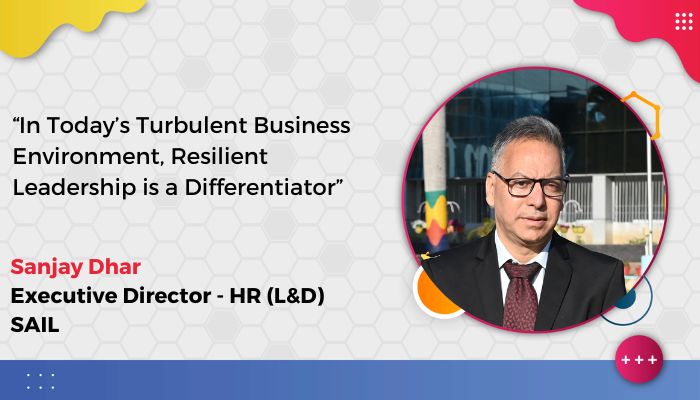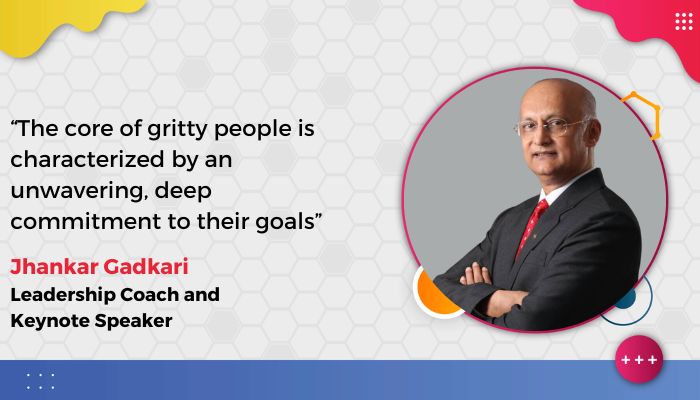By Parul Makkar, Human Resources Lead, JSI
Let us begin by admitting that I hear you when you find the notorious Work-Life-Balance (WLB) in India only in the HR Manuals, company-paid offsites, motivational talks on milestone events and sometimes in those prize-winning Friyay pizza parties. If you’re genuinely engaged with your organisation, your thoughts won’t be ignored or reduced to mere optics. But if you believe work-life balance is just a theoretical concept as useful as an appendix, you might want to keep reading.
Statutory requirements in India around Work Life Balance
The most organised sectors and industries understand the significance of WLB and have developed statutory norms and systems to consider this an employee’s right. Under India’s labour laws, like the Shops and Establishment Act and the Factories Act, 1948, provisions are in place to ensure that every employee is entitled to a regular day of rest. By recognising the need for adequate rest, these legal provisions help maintain physical, mental and holistic health, ensuring employees can recharge and remain productive in the long run, ultimately contributing positively to increasing the ‘returns on investment’ (RoI) made on them by their employer. These laws act as a safeguard, ensuring that employees are not exploited and have a reasonable opportunity to balance their personal and professional lives. Violation of these provisions can lead to legal consequences for employers, including penalties and fines.
Debate about working hours
Despite the statutory requisites and a non-negotiable labour code, I stumbled upon a recent news report that not only dared to tweak these norms but also managed to bring first-of-its-kind legal amendments to suit their needs. The article speaks highly of an electronics manufacturing giant for proudly becoming the first company in South Korea to secure government approval, allowing its employees to work beyond the country’s legally mandated 52-hour workweek. Under the new guidelines, their employees can now work up to 64 hours per week for the first three months, and up to 60 hours per week for the following three months—a notable increase from the previous nationwide cap.
There is an ongoing debate around extended working hours in the corporate sector in India following certain notable leaders giving their opinion on productivity, making the work-life balance concept seem far-fetched.
Industries’ stand on WLB
To honour the statutory norms and humane needs, policymakers in industries and corporations have not missed including the WLB in their HR manuals. However, when it comes to practising these policies, they mostly end up oiling the machines only for the optics. According to Gallup’s 2024 State of the Global Workplace Report, a staggering 41% of employees globally report experiencing daily stress — the highest level Gallup has ever recorded. This leads employers to initiate a deep and thorough process to identify and understand the nuances of keeping an overworked, exhausted, and emotionally drained human capital.
Organisations think WLB is a costly affair which will disrupt operations and will hardly reap any profitability for the business. But not those who have done the math. In 2015, GAP, an established clothing retail company, ran an experiment to figure out how much it would cost to make employees’ schedules more predictable and flexible. To help with predictability, the chain ended on-call shifts and began providing work schedules two weeks in advance; to increase flexibility, it offered electronic shift-swapping, added hours for part-timers who wanted them, and increased peak-hours staffing.
The results were eye-opening. After nine months, workers reported that they were better able to deal with WLB challenges. Supervisors found the changes to be manageable and said that they had improved associates’ morale and productivity. Best of all, instead of costing the chain money, the changes increased sales by 7% and labour productivity by 5%.
Achieving Work-Life-Balance – Employee’s Perspective
I have observed that the principle of Reflect, Refine, Repeat works wonders to maintain a sound WLB. It endorses an individual to:
- Set a periodic assessment of one’s life and work
- Take a step back and observe patterns that cause stress or burnout for them
- Set boundaries at work and in personal life, if and when needed
- Park the guilt outside your system
- Take conscious decisions; they might be life-changing, but equally necessary and rewarding
- Keep revisiting the cycle; it needs your attention.
Offering Work-Life-Balance – Employer’s Perspective
Many employers believe that employees who take advantage of WLB will do less work and that overseeing them will become harder. In other cases, the problem is practical: Organisations simply don’t have the tools to administer systems of support for everyone and to push people to use them. The following practices can help address those issues:
- Introduce WLB programs/policies in writing, covering the benefit, means of administering work output, and penal consequences of policy misuse.
- Leaders should walk the talk. This helps build a culture step-by-step. Leaders should leave at a fixed time and avoid work-related emails or urgent needs on the weekends. This helps employees also learn from their leaders, and they subconsciously follow suit. Imagine – the same citizens of our country do not spit or deface the metro rails, which is unfortunately not the case in the general railway system.
- Use technology and planning to coordinate. Collaboration and communication platforms such as Slack, Microsoft Teams, etc., can make flexible scheduling easier to manage.
- Measure output and not clock-in/clock-out time. Move out of your mental biases.
- Reward WLB Champions also when you celebrate high sales/successes.
WLB programs are a remarkably powerful resource for employees and employers alike. When employees don’t have to struggle for a flexi-schedule to meet their personal/family needs, they can focus more on their work. When managers pay attention to employees’ output rather than hours clocked in, they can focus on improving the performance of their teams. Organisations that are regularly implementing real (not delusional) WLB programs, do not have to worry about losing workers who are good at their jobs. As a result they do not have to worry about the cost of hiring and training replacement hires and they also enjoy the perks of higher customer satisfaction in the service industry and higher productivity in the manufacturing units. Such organizations are proof that WLB is not just for manuals or checklists!
About Parul Makkar
Parul Makkar is a double MBA in Human Resource Management and Finance domains and has a Talent Management certification from XLRI, 16 PF certification in psychometric profiling and HR 40 under 40 Future HR Leader certification to her credit. She is a hands-on Human Resource practitioner with over 18 years of experience of HR business partnering, strategic intervention in planning, acquisition and management of human capital, designing and implementing organisation development initiatives fostering employee growth, change management, training & development, designing capacity building models, HR P&P, compensation and benefits, total rewards and statutory compliances to suit an agile and resilient work culture. She has worked extensively in the hospitality, aviation and development sectors. She has written and presented HR Papers at reputed hospitality and business schools and has been on the HR panel discussions of multiple prestigious platforms.
Disclaimer: The opinions and views expressed in this article, including any accompanying data, are the sole responsibility of the author and should not be construed as reflecting the official policy or position of India Employer Forum.






